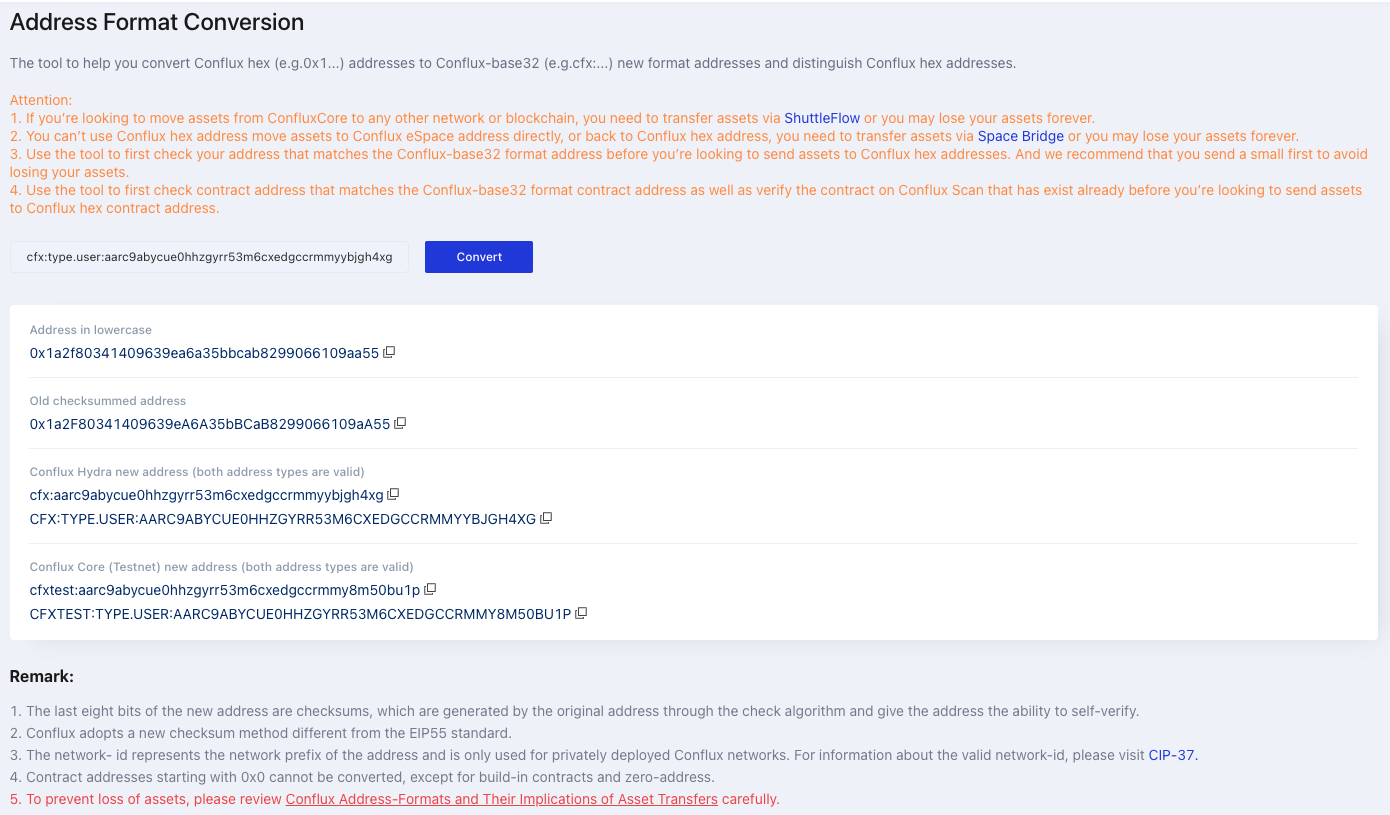Base32 地址
在 Conflux 网络中,每个 ��账户 都与一对公钥和私钥相关联,并通过一个地址来识别。 本页面介绍地址在core space中的表示和计算方式。
关于地址的基本概念,请参阅 General-address。
Hex地址 和 Base32 地址
在 Conflux-rust v1.1.1发布之前,Conflux 地址完全以十六进制编码字符串形式呈现,例如 0x1292d4955b47f5153b88c12c7a94048f09839 此格式与Etherum和其他兼容的EVM区块链使用的地址非常相似。 然而,Conflux 采用了独特的方法来计算 EOA 地址,这意味着 **从相同的私钥生成的地址字符串在 Conflux 和 Ethereum 之间通常会有所不同。**这种外观上的相似性,加上计算上的差异,很容易让用户将 Conflux 地址与 Ethereum 地址混淆,可能导致资产的损失。
为了解决这个问题,Conflux在 CIP-37 中引入了一个新的基于 base32 编码地址格式。 新格式 直接从原始的十六进制编码地址派生,包括一个独特的前缀(如"cfx")、一个可选的地址类型和一个校验和。 因此,上文提到的Hex编码地址可以转换成更容易识别的base32地址。例如 cfx:aakkfzezns4h8ymx1cgmcnd4x3aev6e2hexz250ym5, 可选的,也可以表示为详细格式地址,详细格式包含了非必须的地址类型信息, 例如 CFX:TYPE .USER:AAKKFZEZNS4H8YMX1CGMCN4X3AEV6E2HEXZ250YM5. 这种新格式最大限度地减少了Conflux 和 Etherum地址之间混淆的风险,提供了更安全和更方便的用户体验。
Base32 地址在 Conflux Core 生态系统中被广泛使用,智能合约 .sol 源代码除外。 在.sol文件中需要硬编码EIP-55 校验和地址的情况下,开发人员应该选择使用Conflux的十六进制编码地址,而不是Base32格式。
地址计算
本节内容仅供信息参考。 用户或开发者通常不需要自己计算十六进制地址。 建议基于 SDK 或 RPC 的返回值来获取 EOA / 合约地址,使用 SDK 或 在线地址转换器 来转换十六进制和 base32 地址格式。
十六进制地址计算
Base32地址直接由原始的十六进制编码地址派生而来。 因此,我们需要理解十六进制地址的计算方法。
Conflux 十六进制地址是一个20字节的十六进制值,以“0x”开头的包括42个字符的字符串表示。 十六进制编码地址以一个1(3)字符“类型标识”开头,表示地址类型。 目前有三种类型的标识:
(0x)1: 代表一个EOA 帐户的地址(0x)8: 代表一个合约的地址(0x)0: 表示一个在链上实现硬编码逻辑 内置合约, 或一个空地址 (0x0000000000000000000000000000000000000000000000000000)。
EOA 十六进制地址计算
EOA 十六进制地址的计算在 Conflux 协议规范 3.1:账户中有具体说明。 将账户公钥进行Keccak运算�得到摘要,账户地址由4位类型标识和该摘要的最右侧156位串联而成。
合约地址计算
参见下面的示例。
- Abi
- Bytecode
[{
"inputs": [
{
"internalType": "uint256",
"name": "inputValue",
"type": "uint256"
}
],
"name": "increment",
"outputs": [
{
"internalType": "uint256",
"name": "",
"type": "uint256"
}
],
"stateMutability": "pure",
"type": "function"
}]
0x608060405234801561001057600080fd5b506101a1806100206000396000f3fe608060405234801561001057600080fd5b506004361061002b5760003560e01c80637cf5dab014610030575b600080fd5b61004a600480360381019061004591906100b1565b610060565b60405161005791906100ed565b60405180910390f35b600060018261006f9190610137565b9050919050565b600080fd5b6000819050919050565b61008e8161007b565b811461009957600080fd5b50565b6000813590506100ab81610085565b92915050565b6000602082840312156100c7576100c6610076565b5b60006100d58482850161009c565b91505092915050565b6100e78161007b565b82525050565b600060208201905061010260008301846100de565b92915050565b7f4e487b7100000000000000000000000000000000000000000000000000000000600052601160045260246000fd5b60006101428261007b565b915061014d8361007b565b925082820190508082111561016557610164610108565b5b9291505056fea26469706673582212208eb410cb79fbf08652e19d496e31d076d04be7ed242c64a44aec4c5af0f2533b64736f6c63430008130033
可选的,合约可以通过 create2 操作码进行部署。
合约地址的计算方式与以太坊有很大不同。
如果使用 create2 那么可以按照下面的代码进行计算合约地址:
Create2Factory 合约已经通过 CIP-31 部署, 您可以使用 0x8a3a92281df6497105513b18543fd3b60c778e40 合同或部署您自己的 Create2Factory 合约。
- Python
- Javascript
# using web3.py is also viable
# from web3 import Web3
from conflux_web3 import Web3
# ensure salt is a bytes32 to avoid unmatched result caused by encoding approach
def compute_address_using_salt(
salt: bytes, bytecode_hash: bytes, create2_factory_address: str
):
core_part = Web3.solidity_keccak(
["bytes1", "address", "bytes32", "bytes32"],
["0xff", create2_factory_address, salt, bytecode_hash],
)
return "0x8" + core_part.hex()[-39:]
if __name__ == "__main__":
salt = (1111).to_bytes(32)
bytecode_hash = Web3.solidity_keccak(["bytes"], [bytecode])
create2_factory_address = "0x8A3A92281Df6497105513B18543fd3B60c778E40"
address = compute_address_using_salt(
salt=salt,
bytecode_hash=bytecode_hash,
create2_factory_address=create2_factory_address,
)
print(address) # 0x80ac53cc16c0b58dc5bde5af47f5ef9e84693fe4
import { solidityPackedKeccak256, toBeHex } from "ethers"; // ethers v6
function computeAddressUsingSalt(
salt,
bytecode,
create2FactoryAddress = "0x8A3A92281Df6497105513B18543fd3B60c778E40"
) {
const hash = solidityPackedKeccak256(
["bytes1", "address", "bytes32", "bytes32"],
[
"0xff",
create2FactoryAddress,
toBeHex(salt, 32),
solidityPackedKeccak256(["bytes"], [bytecode]),
]
);
return `0x8${hash.slice(-39)}`;
}
computeAddressUsingSalt(1111, bytecode) // 0x80ac53cc16c0b58dc5bde5af47f5ef9e84693fe4
If create2 is not used, for example, deploy a contract by sending a transaction with no "to" field, the deployed address is computed as the following code described:
The transaction
datais the bytecode of the contract in the aforementioned case. Thebytecode_hashneeded for computing the address is the Keccak-256 hash of the contract bytecode.
- Python
- Javascript
# using web3.py is also viable
# from web3 import Web3
from conflux_web3 import Web3
def compute_address_using_nonce(
nonce: int, bytecode_hash: bytes, hex_deployer_address: str
):
core_part = Web3.solidity_keccak(
["bytes1", "address", "bytes32", "bytes32"],
["0x00", hex_deployer_address, nonce.to_bytes(32, "little"), bytecode_hash],
)
return "0x8" + core_part.hex()[-39:]
if __name__ == "__main__":
nonce = 1
bytecode_hash = Web3.solidity_keccak(["bytes"], [bytecode])
# The address of the transaction sender "cfx:aamz08kfa8wsu69jhhcgrwkjkh69p85wj6222847yp" in hex is 0x155B792507a4E873e839c466C92849f9F67b7247.
hex_deployer_address = "0x155B792507a4E873e839c466C92849f9F67b7247"
address = compute_address_using_nonce(
nonce=nonce,
bytecode_hash=bytecode_hash,
hex_deployer_address=hex_deployer_address,
)
print(address) # 0x837f77a1e8da5b860905a07bc1921e43fbfb04ef
import { hexlify, solidityPackedKeccak256, toBeArray, zeroPadBytes } from "ethers";
function computeAddressUsingNonce(nonce, bytecode, hexDeployerAddress) {
const hash = solidityPackedKeccak256(
["bytes1", "address", "bytes32", "bytes32"],
[
"0x00",
hexDeployerAddress,
hexlify(zeroPadBytes(toBeArray(nonce).reverse(), 32)),
solidityPackedKeccak256(["bytes"], [bytecode]),
]
);
return `0x8${hash.slice(-39)}`;
}
computeAddressUsingNonce(1,bytecode,"0x155B792507a4E873e839c466C92849f9F67b7247") // 0x837f77a1e8da5b860905a07bc1921e43fbfb04ef
It should be noted that in Ethereum, the contract bytecode is not taken as the input of the address computation, but only the nonce and the sender's address are taken as the input.
Base32地址计算
Conflux的 base32 地址指由 CIP-37 定义的具有网络前缀的Conflux Base32校验和地址。 该地址由表示该地址有效的网络的网络前缀、一个冒号(":") 和一个 Base32 编码的载荷组成,并包含一个校验和,例如cfx:aarc9abycue0hzgyr53m6cxedgccrmybjgh4xg。 可选的,地址可以在网络前缀和载荷之间包含一组键值对,格式为key.value,以冒号分隔,例如cfx:type.user:aarc9abycue0hhzgyrr53m6cxedgccrmmyybjgh4xg。
网络前缀(Network Prefix)
网络前缀 是以下值之一: "cfx" (代表主网, 对应于网络 ID 1029), "cfxtest" (测试网, 相对应网络ID 1), "net[n]" n !=1,1029 (代表私有Conflux网络)
有效的网络前缀示例: "cfx", "cfxtest", "net17"
无效的网络前缀示例: "bch", "conflux", "net1", "net1029"
地址类型(Address Type)
地址类型是一个可选字段�,为地址类型提供可读的信息。 对于空地址 (0x000000000000000000000000000000000000000000), 地址类型必须是 type. null。 其他为:
0x0:type.builtin0x1:type.user0x8:type.contract
载荷 (Payload)
- 拼接
版本字节(version-byte):将版本字节(0x00) 与十六进制地址拼接起来,得到一个21字节数组。 - Base32 编码:将以上结果从左到右编码,将每5位序列映射到对应的 ASCII 字符(见下文字母表)。 在结尾补零位(应为2个零位),以完成未完成的任何块。
0x00 => a 0x08 => j 0x10 => u 0x18 => 2
0x01 => b 0x09 => k 0x11 => v 0x19 => 3
0x02 => c 0x0a => m 0x12 => w 0x1a => 4
0x03 => d 0x0b => n 0x13 => x 0x1b => 5
0x04 => e 0x0c => p 0x14 => y 0x1c => 6
0x05 => f 0x0d => r 0x15 => z 0x1d => 7
0x06 => g 0x0e => s 0x16 => 0 0x1e => 8
0x07 => h 0x0f => t 0x17 => 1 0x1f => 9
校验和(Checksum)
- 准备输入校验和输入:
data被用作校验和函数的输入。 它包含:网络前缀每个字符的低 5 位,例如"cfx..."变成0x03, 0x06, 0x18, ...- 分隔符(5比特0)。
- 5位一组将载荷分块。 如果需要,使用0在载荷的最右侧进行填充,以便恰好将载荷分为5位1组。
- 八个零作为校验和的"模板"。
- 计算校验和:使用比特币现金校验和算法计算
data的校验和。 - Base32编码:根据 Payload-Base32编码中的相同步骤编码返回的 40位校验和。
最终结果和示例
连接这些部分就能获得最终地址: [network-prefix], ":", [payload], [checksum]
- 可选的,可以在其中包含address-type:
[network-prefix],":",[address-type],":",[payload],[checksum]
下面是一个展示了编码各步骤的例子:
encode(0x1a2f80341409639ea6a35bbcab8299066109aa55, "cfx")
1. address-type: "type.user"
2. version-byte: 0x00
3. payload: [0x00, 0x1a, 0x2f, 0x80, 0x34, 0x14, 0x09, 0x63, 0x9e, 0xa6, 0xa3, 0x5b, 0xbc, 0xab, 0x82, 0x99, 0x06, 0x61, 0x09, 0xaa, 0x55]
5-bit parts: [0x00, 0x00, 0x0d, 0x02, 0x1f, 0x00, 0x01, 0x14, 0x02, 0x10, 0x04, 0x16, 0x07, 0x07, 0x15, 0x06, 0x14, 0x0d, 0x0d, 0x1b, 0x19, 0x0a, 0x1c, 0x02, 0x13, 0x04, 0x03, 0x06, 0x02, 0x02, 0x0d, 0x0a, 0x0a, 0x14]
base32-encoded: "aarc9abycue0hhzgyrr53m6cxedgccrmmy"
4. checksum input: [0x03, 0x06, 0x18, 0x00, 0x00, 0x00, 0x0d, 0x02, 0x1f, 0x00, 0x01, 0x14, 0x02, 0x10, 0x04, 0x16, 0x07, 0x07, 0x15, 0x06, 0x14, 0x0d, 0x0d, 0x1b, 0x19, 0x0a, 0x1c, 0x02, 0x13, 0x04, 0x03, 0x06, 0x02, 0x02, 0x0d, 0x0a, 0x0a, 0x14, 0x00, 0x00, 0x00, 0x00, 0x00, 0x00, 0x00, 0x00]
checksum output: 688543492710
checksum string: "ybjgh4xg"
5. concatenated result: "cfx:type.user:aarc9abycue0hhzgyrr53m6cxedgccrmmyybjgh4xg"
Base32 和十六进制地址的使用场景
Conflux Core RPC 方法仅接受 base32 地址,因此 Conflux Core SDK 和钱包也使用 base32 地址。 Base32 是 Core Space 中最常见的地址格式。
对于 Conflux Core Space 合约开发,可以使用 Ethereum 工具链编译合约。 因此,在 Solidity 智能合约 .sol 文件中,base32 格式地址会导致编译错误。 如果需要在合约代码中硬编码特定地址,它应该使用十六进制格式。 这是在 Core Space 中使用十六进制地址的唯一情况。
地址格式转换工具
ConfluxScan provide a Online Address Converter which is very useful.

常见问题解答
如何在 base32 和十六进制地址之间转换?
Use the Online Address Converter or the SDKs to convert between base32 and hex addresses.
我什么时候应该使用十六进制地址?
在 Core Space 中,十六进制地址仅在 Solidity 智能合约 .sol 文件中使用。 在其他情况下,使用 base32 地址。
我可以在 Conflux Core Space 中使用 Ethereum EOA 地址吗?
不能。 Ethereum EOA 地址并不完全兼容 Conflux 地址。 建议使用 Conflux 钱包或 SDK 生成 Conflux base32 地址。
Conflux Core Space 的 BIP-44 币种类型是什么?
Conflux Core Space 的 BIP-44 币种类型是 503。